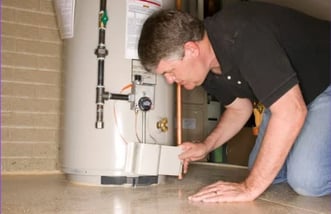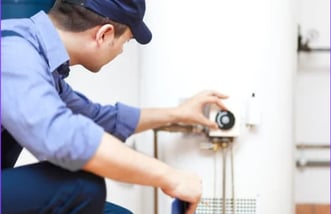How to Relight a Pilot Light on a Water Heater
A water heater can make daily chores like bathing and dishwashing more manageable. So when a pilot light on a conventional water heater goes out, your home will be without hot water unless it’s relit. Relighting a conventional water heater is simple enough for most homeowners, and we’ll show you how!
For over 15 years, we’ve become water heater experts after servicing thousands of homes across Los Angeles and the surrounding areas. At Monkey Wrench Plumbing, Heating & Air, our technicians are certified and have plenty of years of experience with relighting pilot lights, which is something many homeowners can accomplish on their own.
Here are the steps required to relight a pilot on a conventional water heater:
- Shut off the gas access to the conventional water heater
- Locate the pilot light on the conventional water heater
- Adjust the gas control knob to the pilot position
- Press and hold the knob
- Press the igniter button or manually turn the flame on with a lighter
- Hold the knob and release it once the flame is produced
- Confirm pilot light is relit
We will go over each of the steps in detail so that at the end of this article, you will feel confident knowing your pilot light is lit and able to help your water heater produce hot water your family can rely on.
Now, let’s get started!
How Do I Light My Water Heater’s Pilot Light?
These steps are a general overview of how to relight a pilot light of a conventional water heater. Although there are multiple water heater brands, most conventional water heaters have similar instructions for relighting a pilot light. Refer to your conventional water heater’s user manual for more information.
Homeowners can do the following steps, but a certified technician can also do it. Aside from relighting a pilot light, a professional technician can perform maintenance on the conventional water heater and inspect it for any underlying issues.
Contacting a technician is also highly recommended if you encounter any difficulties when relighting a pilot light. Nevertheless, to make things a little easier, here’s a step-by-step breakdown of how to relight a pilot light on a conventional water heater.
1. Turn the Gas Valve Off
Conventional water heaters with pilot lights are fueled by natural gas, so the first step is to locate and shut the gas valve off. Gas lines are usually yellow and easy to distinguish from water lines.
When approaching the gas valve, pay attention to any lingering odors you may pick up. If you smell a strong gas smell or rotten egg smell, you could have a gas or carbon dioxide leak. Gas leaks are dangerous and may also be why the pilot light went out. It is highly recommended to contact SoCal Gas to report the gas leak so it can be attended to immediately.
If you don’t smell any gas, then proceed to shut the gas valve off. The valve usually has a lever that can be pushed or pulled into an off position. Once it’s shut off, wait at least five minutes to allow any remaining gas to evaporate before moving to the next step.
2. Locate the Pilot Light
After shutting off the gas valve, you will need to locate the pilot light assembly. The pilot light is usually on the bottom of the tank, outside or behind an access panel. 
A homeowner removes the access panel of a conventional water heater.
You may need a flathead screwdriver to open the panel. Depending on where your water heater is stored, you may need a flashlight to see the panel. The pilot light is a knob that is turned left or right or a switch that can be flicked up or down.
Once you’ve identified the pilot light control, you can proceed with the next step.
3. Set the Gas Regulator Valve to the Pilot Position
If the gas regulator is knob, turn and set it to pilot position. If the conventional water heater has a switch instead of a knob, set it to pilot position.
Regardless of the layout, the water assembly should have “pilot” written on it so it’s easy for anyone to identify where to set it. This action requires minimal effort, but a few people have reported their knob being too hard to turn. You may need to use pliers or contact a technician for further assistance setting the assembly to the pilot position.
A man adjusts the gas control knob of a conventional water heater.
After setting the pilot light position, you’ll need to complete a few more steps before it’s relit again. We recommend reading steps four, five, and six back-to-back to help facilitate the relighting process.
4. Press the Knob on the Front and Hold it
Depending on the pilot light assembly, you made need to push and hold the knob once it’s set to the pilot position. If the assembly is a switch, then there’s usually a button you can press and hold down.
Holding down the knob or button allows gas to enter the pilot tube. The tube also provides a constant supply of gas to the igniter to keep the flame on.
As you hold down the button or knob, you will next activate the ignition to start the relighting process.
5. Press the Igniter Button or Manually Ignite the Flame
With one hand pressing the knob or button supplying gas, the free hand presses the igniter button to start the burner. A conventional water heater’s burner assembly has an igniter button near the pilot light assembly.
Alternatively, some older conventional water heaters may not have an igniter button on the assembly. A long barbecue lighter is needed to help provide a flame to the burner. If your current water heater has this setup, it may be time to consider replacing an old unit with a new conventional water heater, especially if you don’t see any flame lit up.
6. Continue Holding the Knob Until There’s a Flame
Simultaneously, holding the pilot light knob and igniter button should produce a flame, but you should still hold the knob for at least another 30 seconds. You will need to release the pilot light knob and then visually check if there’s a flame burning.
Some conventional water heaters have an indicator light that turns on once a flame is present. Whether it has it or not, it’s still recommended to confirm there’s a flame lit up.
7. Confirm Pilot Light Is On
If you see the flame lit up, the conventional water heater has a heating source again. The final step is to turn the gas regular knob or switch from “pilot” position to “ON.”
Once it’s set on, you can adjust the conventional water heater’s thermostat to the desired temperature of the hot water. After a few minutes, you can test if your home has hot water by turning on a hot water fixture and letting the hot water run for five minutes.
On the other hand, if you don’t see a flame produced after releasing the gas control knob, you will need to repeat steps four, five, and six to see if the flame lights up. If you still don’t see a flame after repeating the process, it’s recommended that you contact a water heater technician for further diagnostics.
There could be a couple of reasons why your conventional water heater’s pilot isn’t lighting up, but a certified technician can determine the root cause after an inspection.
What to Do if the Pilot Light Turns Off Again?
Once it’s lit, the pilot light should stay on again. If it goes off, you now have the steps to relight the pilot light successfully. If the pilot light turns off repeatedly, it’s best to contact a technician to inspect the conventional water heater.
From Los Angeles to Orange County, we’ve helped homeowners with servicing their conventional water heaters, including their pilot lights. Although pilot lights don’t always go out, we believe it’s best to share our insider knowledge with homeowners so they have the resources to relight their conventional water heater’s pilot light.
If you need help with a water heater pilot light, contact us using one of the buttons below or book an appointment through our online water heater repair scheduler.
Pilot lights aren’t the only issues that may occur with conventional water heaters. Learn about some common problems with conventional water heaters so you can prepare yourself for the unexpected.




